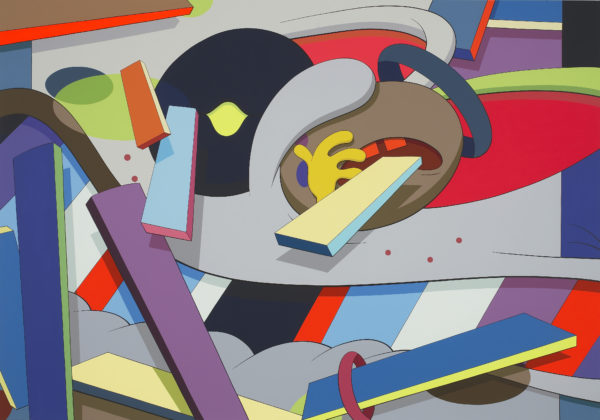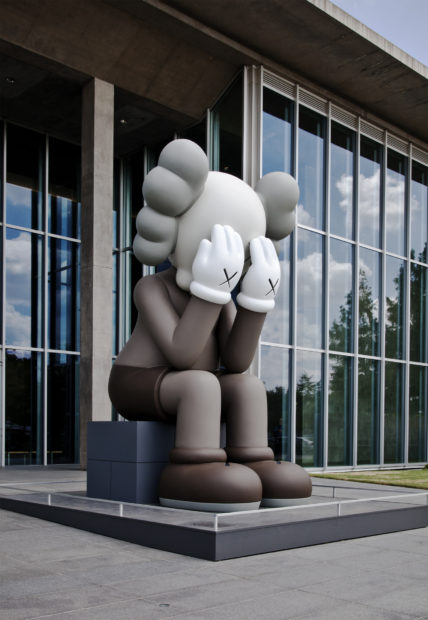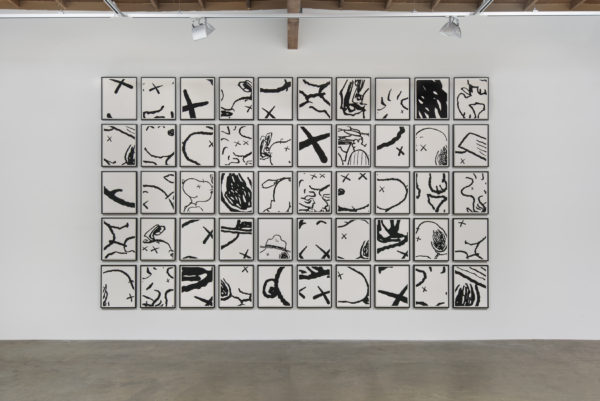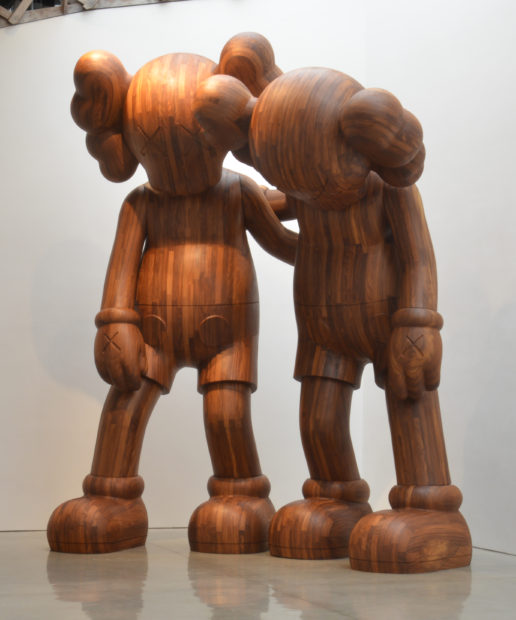WHERE THE END STARTS, a KAWS’ painting from 2011, lends its title to a large survey exhibition by the artist at the Modern Art Museum of Fort Worth. In the painting, we see a yellow, four-fingered hand emerging from what looks like an interdimensional vortex. In a whirlwind of shapes and colors, drawn up in the ubiquitous style of popular TV cartoons, the yellow hand, familiar to us as a re-incarnation of The Simpsons, seems to come from nowhere. Operating from a realm that is simultaneously not quite art, design or comics, KAWS presents a world of unsettling familiarity, devoid of meaning and purpose.
The work in the exhibition is in fact Brian Donnelly’s, a graffiti artist who began working under the moniker KAWS during the late ‘80s and early ‘90s in New York City. First gaining notoriety for subverting bus and phone booth advertisements, KAWS was then scouted by commercial interests for work in advertising. In 1999, a pivotal opportunity presented itself when KAWS was asked to create a limited edition toy figure for a Japanese clothing brand. The figure became an instant success, and propelled KAWS into a global brand replete with a toy store in Tokyo, designer clothing lines and sneakers, among other current ventures.
In the early 2000s, KAWS’ brand of collectibles began to expand into the mainstream art world with The Kimpsons, a series of paintings packaged, in plastic, like a collectible toy. The Kimpsons are slightly altered versions of The Simpsons characters in which KAWS has replaced the characters’ eyes with ‘x’es, distorted their mouths, and added protrusions to the sides of their heads. This kind distortion has become KAWS’ signature, which he has applied to a slew of popular cartoon characters including the Smurfs, Snoopy, SpongeBob and even Mickey Mouse. By the end of the decade, KAWS began rescaling his toy figure Companion, based on Disney’s famous mouse, to sculptures over 20 feet high. KAWS’ work literally outgrew its toy status.
As such, KAWS’ paintings and sculptures defy the contemporary art world’s established markers of categorization for artists and artworks. Though reassuring in formula and seriality—and seemingly interchangeable with the cartoons that cue them—the works seem to float, unwed to cartoons, design, toys or art. If not for the slight alterations made by KAWS, like the x-ed out eyes, the exhibition could believably double as Disney or Fox’s merchandising for a more mature and affluent consumer market.
Although KAWS’ works give the appearance of being a continuation of Pop Art, the artist merely repeats what’s already there without going beyond the parameters set by the source material. Absent is a knowing deconstruction of the images, or questioning of value through size and proportion, as in the works of Roy Lichtenstein. Where Lichtenstein approached comics as a painter, KAWS is a cartoonist making paintings. His work also lacks the dimension of political engagement, like Keith Haring’s deliberate clashing of high and low culture. Surprisingly, considering his origins as a graffiti artist, KAWS has repudiated the notion that there is any critical dimension to his use of icons of consumer culture.
KAWS is perhaps more closely related to artists who work by internalizing mass culture, like Jeff Koons and Damien Hirst. The latter is even referenced by KAWS in one iteration of a Companion sculpture, in which the left side of the figure’s skin has been removed to reveal internal organs and bones like a medical doll. There are many similarities in Hirst’s and Kaws’ approach to making art. In both artist’s serialized paintings—like KAWS’ The Kimpsons and Hirst’s pill paintings—the works are as infinitely variable as they are uniform. But for Hirst, the dichotomies of mass production and fine art—consumer culture and high culture, originality and mass production—are precisely the subject matter of his work. For KAWS, this kind of self-reflection is remarkably absent. In fact, there’s more ironic distance, self-awareness, and criticism of consumer culture in the Simpsons than in the Kimpsons.
KAWS has stated that his work, in a sense, is a mirror of his own state of mind, an exploration of humanity and a way of understanding the world around him. The fact that these explorations into the human condition are already the subject of his source material appears to have escaped the imagination of the artist. So the true elusiveness of KAWS is not a question of categorizing this graffiti artist/toy-maker/visual artist. Instead, the question is: can we find the artist in his own work? Nothing in the work of KAWS, including style and subject matter, is very distinguishable from its original inspiration, and the works fail to reflect on the the original imagery or the world of images as a whole. In fact—and crucially—when considering the work’s playfulness, humour, familiarity, and even its formal aspects (composition, line, color), we find that all of these qualities are determined by the source material. It’s as if KAWS has managed to completely forgo the principle of representation.
KAWS’ regurgitation of popular cartoons, for no other reason than the perfunctory accolade “That looks cool,” feels completely incongruous to an art world that is so deeply invested in the original and authentic. It is as though we have entered the upside down, an alien world that resembles our own. Free from the constraints of customs and conventions of the art world, KAWS’ works appear to be perpetuated by a self-contained logic that is hermetic and unyielding, taunting and scoffing at us. Like Bart Simpson, the boy who never grows up, the works only indulge in their own predilections. In an art world that has become more and more cynical about its most treasured claims to independence and authenticity, does KAWS offer us a glimpse at a new mode of making art? Or was Warhol right when he said “Art is what you can get away with”?
Through Jan. 22 at the Modern Art Museum of Fort Worth.







3 comments
Of course Warhol was right. I’m living proof. I highly recommend the show ( The Modern is my favorite museum up North .) Yes contemporary arts are fucking mess!
He is a marketing genius! He outdoes Koons and Wharhol. Like pop, he rips everyone off. That said, it’s a fun show. I never saw so many people taking “selfies” at a museum.
Well thought out review and commentary on intention and authenticity in the art world. What passes for originality in todays market is astounding.